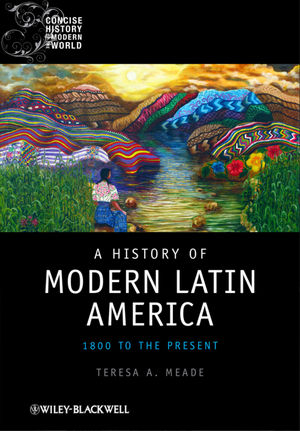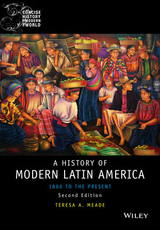
A History of Modern Latin America
Wiley-Blackwell (an imprint of John Wiley & Sons Ltd) (Verlag)
978-1-4051-2051-7 (ISBN)
- Titel erscheint in neuer Auflage
- Artikel merken
A History of Modern Latin America: 1800 to the Present examines the diverse and interlocking experiences of people of indigenous, African, and European backgrounds from the onset of independence until today. Illustrates and analyzes the major and minor events that shape history, the triumphs and defeats, and the everyday lives of people of varied classes and racial and ethnic backgrounds Intersperses accounts of the lives of prominent figures with those of ordinary people Emphasizes gender's role in influencing political and economic change and shaping cultural identity Student and instructor resources available at http://minerva.union.edu/meadet/modernlatinamerica/index.html [Wiley disclaims all responsibility and liability for the content of any third-party websites that can be linked to from this website. Users assume sole responsibility for accessing third-party websites and the use of any content appearing on such websites. Any views expressed in such websites are the views of the authors of the content appearing on those websites and not the views of Wiley or its affiliates, nor do they in any way represent an endorsement by Wiley or its affiliates.]
Teresa A. Meade is Florence B. Sherwood Professor of History and Culture at Union College, New York. She is the author of "Civilizing" Rio: Reform and Resistance in a Brazilian City (1997), A Brief History of Brazil , 2 nd edition (2009), and co-editor of the Blackwell Companion to Gender History (2004) and Science, Medicine and Cultural Imperialism (1991). She has written widely on Latin America, and on women and gender history.
List of Figures List of Maps Preface Acknowledgments 1 Introduction to the Land and Its People Geography People Economies Politics Culture and Entertainment Latin America: Past and Present 2 Latin America in 1790 Colonial Background Power and Privilege Land Colonial Administration Enlightened Monarchy The Agents of the Reform Disorder and Rebellion Discontent and Disorder in Brazil Changing Gender Roles On the Road to Independence Nationalism and American Culture Conclusion 3 Competing Notions of Freedom Five Roads to Independence African Slavery in the Americas Slavery and the Countryside Slavery in the Cities Treatment and Punishment Slavery and the Church African Medicine and Religious Practices Resistance and Rebellion The Sugar Colony of Saint-Domingue The Slave Revolt The Revolution Betrayed Brazil's Independent Empire Independence in Mexico South American Independence Post-independence Changes in Racial and Gender Status The Last Holdout of Slavery in Spanish America Latin America in a Changing World Order Conclusion 4 Fragmented Nationalisms Searching for Political and Economic Unity New World "Feudalism" Post-independence Politics Argentina and the Tyrants Populist Caudillismo : Paraguay and Bolivia After Caudillismo Race, Race Mixture, and Liberalism Gender and Liberalism Intersections of Gender, Race, and Class Nationalism Conclusion 5 Latin America's Place in the Commodity Chain The Guano Boom Nitrates in Chile Sugar and Coffee The Growth of Sao Paulo Colombian Coffee The Rubber Boom Expanding Exports Mexico and US Expansion The North American Invasion General Lopez de Santa Anna The New Age of Imperialism Central America and the Panama Canal Ecuador and the "Panama" Hat Independence at Last? Cuba and Puerto Rico Conclusion 6 Immigration, and Urban and Rural Life Asian Immigration European Immigration The Southern Cone Life on the Pampas British Investment The Changing Cultural Landscape Urban Renewal Mexico and Benito Juarez French Invasions The Rise of Porfirio Diaz Intellectual Theories: Positivism and Eugenics Conclusion 7 Revolution from Countryside to City: Mexico The Porfiriato Opposition to the Porfiriato Constitutional Opposition Madero Assassinated US Intervention Women in Combat Carranza as President The Constitution of 1917 Aftermath of Struggle Agrarian Revolts in Latin America Conclusion 8 The Left and the Socialist Alternative Socialism on the World Stage Social Reform and the Middle Class Anarchism, Socialism, and Anarcho-syndicalism Women in the Workforce Colombia: Resistance to the United Fruit Company The Labor Movement Socialism and the Arts Tenentes Revolt and Brazilian Communism Modern Art Week in Brazil Women in the Arts Socialism vs. Capitalism Jose Carlos Mariategui Conclusion 9 Populism and the Struggle for Change Getulio Vargas and "New State" Politics Juan Peron and Peronism Peron's Fall from Grace Politics Engendered Revolutionizing Mexico: Lazaro Cardenas Populism in Colombia and Peru Central America The Long Twentieth Century Conclusion 10 Post-World War II Struggles for Sovereignty World War II Temporary Worker Program Post-war Latin America Military vs. Civilian Rule The Absolute Dictator: Rafael Trujillo Americas in Transition: Guatemala and Bolivia Guatemala Revolution in Bolivia Mining and the Voice of Bolivian Activism The Revolution in Decline Conclusion 11 Cuba: Guerrillas Take Power "History Will Absolve Me" Causes for Discontent The Revolutionary War The Special Period in Peacetime Cuba and the World Ernesto "Che" Guevara What Difference Did the Revolution Make? Democratic Shortcomings Conclusion 12 Progress and Reaction Modernization and Progress Brazil's Military Coup The National Security State Latin America's Youth Movement Mexico The Massacre at Tlateloco The Chilean Road to Socialism The Chilean Road to Socialism Dead Ends Urban Guerrilla Warfare: Uruguay Urban Guerrilla Warfare: Argentina Dictatorship and State Terror Mothers of the Plaza de Mayo The War of the Malvinas/Falkland Islands Movements for Revolutionary Change: Peru Sendero Luminoso , the Shining Path Women and Shining Path Repression and Fujimori Conclusion 13 Revolution and Its Alternatives A Changing Catholic Church Marxism and Catholic Humanism The Opposition The Somozas versus Sandino: the Next Generation The Sandinista Opposition Sandinistas in Power United States and the Sandinistas Effects of the Contra War Central America in Turmoil: El Salvador and Guatemala Politics of Repression in El Salvador The Opposition The Fighting Ends Guatemala: The Bloodiest War The Evangelical Alternative Colombia: The Longest War The War on Drugs in Latin America Conclusion 14 The Americas in the Twenty-first Century The Washington Consensus Brazil and the Workers' Alternative The Workers' Party in Power Bolivia: Twenty-first-century Indigenismo Venezuela and Hugo Chavez The Bolivarian Mission Chavez and "the Pink Tide" Complicating Social Ties Chile's Transition to Democracy New Social Movements Movements for Racial and Gender Equality Women and Politics The Latin Americanization of the United States Immigration and Free Trade Opponents Confront Free Trade Immigration and Neoliberalism Sharing the Environment and the Cost of Stewardship Notes Glossary Further Reading Index
| Reihe/Serie | Blackwell Concise History of the Modern World |
|---|---|
| Verlagsort | Chicester |
| Sprache | englisch |
| Maße | 172 x 245 mm |
| Gewicht | 730 g |
| Themenwelt | Geschichte ► Allgemeine Geschichte ► Neuzeit (bis 1918) |
| Geisteswissenschaften ► Geschichte ► Regional- / Ländergeschichte | |
| ISBN-10 | 1-4051-2051-7 / 1405120517 |
| ISBN-13 | 978-1-4051-2051-7 / 9781405120517 |
| Zustand | Neuware |
| Haben Sie eine Frage zum Produkt? |
aus dem Bereich



